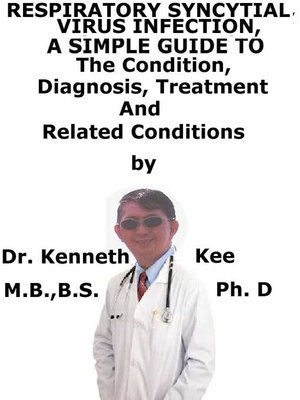Respiratory Syncytial Virus Infection, a Simple Guide to the Condition, Diagnosis, Treatment and Related Conditions
ebook
By Kenneth Kee

Sign up to save your library
With an OverDrive account, you can save your favorite libraries for at-a-glance information about availability. Find out more about OverDrive accounts.
Find this title in Libby, the library reading app by OverDrive.



Search for a digital library with this title
Title found at these libraries:
| Library Name | Distance |
|---|---|
| Loading... |
This book describes Respiratory Syncytial Virus Infection, Diagnosis and Treatment and Related Diseases
Respiratory syncytial virus (RSV) produces infections of the lungs and respiratory tract.
It is so frequent that most children have the RSV infection by age 2.
Respiratory syncytial virus can also affect adults.
In adults and older healthy children, RSV symptoms are mild and normally imitate the common cold.
Self-care measures are normally all that is required to alleviate any discomfort.
Respiratory syncytial virus (RSV) is a very frequent virus that results in mild, cold-like symptoms in adults and older healthy children.
It can be more severe in young babies, particularly those in certain high-risk groups.
RSV can produce serious infection in some people particularly:
1. Premature babies,
2. Older adults,
3. Infants and adults with heart and lung disease, or
4. Anyone with a very weak immune system (immunocompromised).
Respiratory Syncytial Virus infection is produced by a virus and transmitted when an infected person coughs or sneezes.
The respiratory syncytial virus goes into the body through the nose or mouth or very often through the eyes (when people rub their eyes with a hand that has come in contact with infected secretions).
It transmits readily through the air on infected respiratory droplets.
The parent or the child can become infected if some person with RSV coughs or sneezes near them.
The respiratory syncytial virus also passes to others through direct contact, such as shaking hands.
The virus can survive for hours on hard objects such as countertops, crib rails and toys.
If the patient touches the mouth, nose or eyes after touching a contaminated object, the patient is likely to pick up the virus.
An infected person is most infectious in the first few days after infection.
The virus may continue to transmit for up to a few weeks.
Risk factors
By age 2 years, 90% children will have been infected with respiratory syncytial virus.
Children who are present at child care centers or who have siblings who attend school are at a higher risk of exposure.
RSV season (when outbreaks are likely to happen) is the autumn (fall) to the end of spring.
People at higher risk of serious or occasionally life-threatening RSV infections are:
1. Young Children
a. Premature infants
b. Young children, particularly those under 1 year of age, who have an underlying disorder, such as congenital heart or lung disease
c. Children with weakened immune systems, such as those going through chemotherapy or transplantation
d. Infants in crowded child care situations
e. Infants younger than 6 months of age
2. Older Children
a. Exposure to other children (e.g., in daycare) or to older siblings going to school
b. Older Children with weakened immune systems
3. Older adults
a. Crowded places with people who may be infected
b. Adults with asthma, congestive heart failure, or chronic obstructive pulmonary disease
c. People with immunodeficiency, such as those with certain transplanted organs, leukemia or HIV
RSV often transmits quickly in crowded households and day care centers.
The virus can survive for a half an hour or more on hands.
The virus can also survive for up to 5 hours on countertops and for many hours on used tissues.
These factors raise the risk for RSV:
1. Attending day care
2. Being near tobacco smoke
3. Having school-aged brothers or sisters
4. Living in crowded conditions
Nasal congestion, runny nose, mild cough,...







